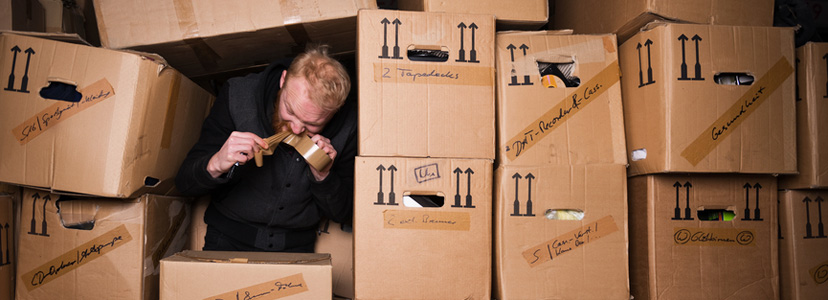Excessive packaging: who are the biggest culprits?

The Nielsen Global Corporate Sustainability Report shows that two thirds of consumers would be willing to pay extra for brands who have adopted sustainable packaging philosophies. So why is excessive packaging an issue within ecommerce and deliveries?
One sure-fire way for companies to respond to this, by demonstrating their commitment to sustainability, is to slim down their packaging. But is this happening? Who is currently being overly excessive with packaging — and how can the situation be improved?
Who are the big offenders?
With a market value of more than $260 billion, Amazon is the largest retailer in the world; having taken first place from Wal-Mart last year.
It is therefore unsurprising that Amazon uses a large amount of packaging, but does it use too much? Clearly, Amazon’s senior management is aware that there is an issue, because, in 2008, following customer complaints about annoying and excessive packaging, the company launched its ‘Frustration Free Packaging’ campaign — with the intent to slim down the excess.
However, as late as February 2016, Amazon customers are still taking to social media to bemoan the wasteful amounts of packaging being used by the retailer. In the run-up to Christmas 2015, for example, one customer received an order of camera lens protectors in a large cardboard box. More recently, another customer’s pack of 12 beer glasses arrived in an outer cardboard box that was about twice the necessary size.
Supermarkets also make blunders when dispatching goods to customers. For example, Tesco recently sent out a 24-piece dinner set to a customer in Greater Manchester. Unfortunately, each piece of crockery was individually boxed — twice — meaning that a total of 48 boxes were used. Worse, some pieces didn’t survive the journey intact.
These examples clearly demonstrate that excessive packaging is pointless. It offers no additional protection to the goods within, and has a detrimental effect on the environment — as well as annoying the consumer. Extra packaging requires more energy and raw material, as well as more fuel for transporting the goods. Every extra ounce per package counts.
What about the smaller retailers?
It’s not just the multinationals that are culpable when it comes to packaging waste. Even the smallest independent business should always be looking for ways to reduce its packaging.
For example, takeaway food businesses may use plastic boxes, or foil trays with cardboard lids, to contain food. Several of these containers may need to be grouped together in a sturdy paper bag. However, is it really necessary to place this paper bag into a plastic carrier bag?
In general, though, smaller businesses need to keep a close eye on their costs, so they will be inclined to use as little packaging as possible. For example, independent traders on eBay must consider postage charges, which forces them to ensure that packages are as light and small as possible.
How can retailers improve their sustainability?
In 2014, online retail sales exceeded £100 billion. By the end of 2016, they are predicted to reach £126 billion. With this trend comes a greater demand for packaging, so it is vital that businesses do all they can to cut back on waste. So, how can new businesses learn from the above examples of excessive packaging?
Consider the camera lens protectors that were sent out in a large cardboard box. In this case, reducing the size of the box is one possible way to cut the excess, but because they were already packaged in a vacuum-packed plastic container, there was no need to send them in any kind of box. A bubble wrap-lined postal bag would have sufficed.
There was also no need for a box for the beer glasses, because they were already contained within one. A better alternative would have been to wrap them in bubble wrap for protection during shipping, with the addition of an outer layer of plastic wrapping to stop the bubbles popping.
In the case of the Tesco dinner set, all the separate components — plates and bowls, for example — could have been stacked together according to type, and layered with sheets of packaging foam. The entire set could then have been wrapped in bubble wrap and placed in a box, with packing peanuts or air pillows added to make sure the pieces of crockery didn’t knock against each other.
The dinner set example also shows how buying in bulk cuts packaging waste, because less packaging is used per unit of goods. Consider how much plastic is needed to contain 500 ml of shampoo as one large bottle, compared with ten separate 50 ml travel size bottles.
To reduce packaging waste, consideration of the physical characteristics of goods, how they are being stored, and how they are being shipped, is essential.
Source reduction
The key message for any new business is source reduction — that is, reducing the volume of material that will end up as waste.
Lighter weight packaging should be used wherever possible, so think about whether you really need double wall cardboard boxes, for example. Will single wall boxes suffice? Also, could you reduce the size of these single wall boxes? This will reduce void space within the package, so less void fill will need to be used.
When packaging is reduced, the environment will benefit, and so will your business: sustainability is important to consumers, it should therefore be important to you.
For more information about getting the right packaging for your business, check out our Retail & Ecommerce section.
Rick Stanford
Latest posts by Rick Stanford (see all)
- Davpack’s Top Tips for Secure Strapping - 7th September 2022
- The Paper vs Plastic Bubble Wrap Debate - 10th August 2022
- Save Money with Royal Mail Sized Packaging - 8th July 2022
